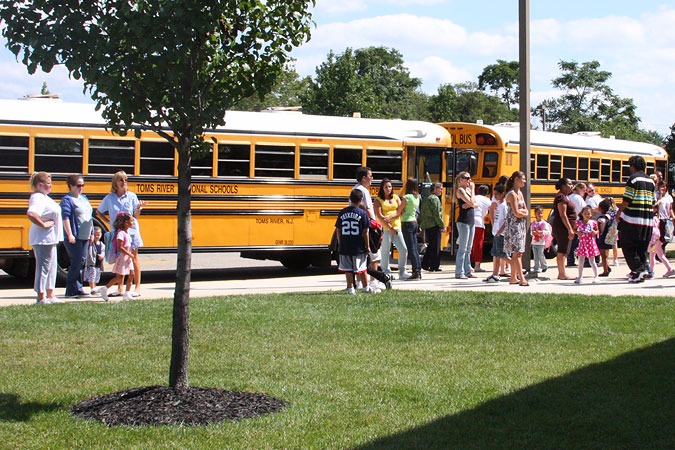
Toms River Regional school students. (Photo: TRRS)
Students will be required to wear masks during the school day and will be placed into groups as part of a hybrid plan that will incorporate both in-person and remote learning, Toms River school officials said this week as they are adapting to the realities of a school year beginning in the midst of a pandemic.
The Toms River Regional school district is still developing its firm plans for the 2020-21 school year, but Superintendent David Healy said at a Board of Education meeting this week that he and his staff are favoring an “A-B” hybrid scheduling model when students return in September.
Under the most likely scenario, students will be divided into cohorts termed group “A” and group “B.” Students in one group will attend classes in-person Mondays and Wednesdays, while the other group will attend Tuesdays and Thursdays. Friday will be a virtual day of learning for all students, and will also give the district a full day to deep-clean facilities.
The A-B model would provide students with 73 days of in-person instruction out of the 180 day school year. The rest of the days would include remote learning, however the district said it is looking to better synchronize students and their teachers by requiring classes to meet at a given time instead of having all work submitted on an open schedule. Teachers will be able to work from home on the designated virtual day, which will give custodial staff the opportunity to deeply clean and disinfect facilities.
“We’re working on everything we can to keep our children safe, but also our staff who are attending to those children,” said Healy, noting that school staff are responsible for tasks up to and including managing disabled students’ feeding tubes and cleaning diapers.
“We’re looking at reconfiguring spaces so we can better accommodate students with disabilities,” Healy said.
Students, under the plan being considered by the district, would be required to wear masks all day, which will last about four hours. Lunch will not be served, but “grab and go” meals may be provided for children who qualify for free or reduced lunch since they may not have the opportunity to eat when they arrive home.
The mask mandate caused concern among some parents, who worried that students could be negatively affected by being forced to wear a face covering in classrooms that are not air conditioned. Healy said the district is in the midst of a $100 million project that will bring air conditioning to the entire district, but it simply will not be ready by September. The district has also ruled out using window air conditioners, citing a combination of their high cost and ineffectiveness in a large classroom setting.
William Doering, the district’s business administrator, said the regional school system will spend over $1 million on masks. Students and teachers may wear their own, but by state mandate, fresh masks must be available for all students and staff, every day.
“If there is no air conditioning, how could masks be worn for four hours in a row?” asked parent Dawn Hans.
“We’re required to have a 20 minute mandated recess and we’re trying to figure out how we’re going to incorporate that into the school day,” said Healy. “I would like to think that the students will have opportunities to take their masks off, get outside and get some fresh air.”
Another parent, who did not provide her name, said students should return to full school days – especially those whose parents are essential workers and cannot arrange child care.
“As a parent, I completely understand your dilemma,” replied Board President Anna Polozzo. “But our teachers are not babysitters, and unfortunately at this time we cannot accommodate full-time, Monday through Friday, instruction in our buildings under the guidance provided by the NJ [Department of Education]. We appreciate the fact that it is a difficult proposition for everyone involved, and we will do everything we can to make the transition easier for you, but parents are going to have to be responsible for providing childcare.”
Healy said the district will make accommodations for students who cannot attend classes in-person.
“We can’t force parents to send their children and we can’t force staff members to come to work,” said Healy. “There will be accommodations made for those students who either can’t come to school or can’t receive those extra services they require.”
There is one precaution that is simply impossible to implement, Healy said. As part of a document promulgated by the New Jersey Education Association, the union that represents teachers, it was requested that all students and staff receive coronavirus tests every week. Healy said the cost of such a measure would add up to about $900,000 each week.
“It’s unrealistic, logistically,” said Healy. “It’s actually impossible.”
Healy said the district will look to state guidelines to prepare for a return of students to in-person classes and will develop a plan that can be adapted in case of sudden changes.
“As conditions change, we’re prepared for multiple scenarios, whether it’s full virtual, a continued hybrid or a full return to school,” said Healy. “We’re going to follow the guidance of the Department of Education and make adjustments where we can.”


Police, Fire & Courts
Thief Robs Toms River Restaurant, Pictured Walking Down Street Carrying Safe

Police, Fire & Courts
Intricate Nature of Toms River Jewelry Heist Revealed; TRPD Has Leads

Police, Fire & Courts
Thief Robs Toms River Restaurant, Pictured Walking Down Street Carrying Safe







